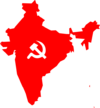- Communist Party of India (Marxist–Leninist)
-
Communism in India Communist Party of India
AITUC - AIKS - AIYF
AISF - NFIW - BKMUCommunist Ghadar Party of India
Naxalbari uprising
Communist Party of India (M-L)
Liberation - New Democracy
Janashakti - PCC - 2nd CC
Red Flag - Class Struggle
Communist Party of India (Maoist)Socialist Unity Centre of India (Communist)
AIUTUC - AIMSS
AIDYO - AIDSOM. N. Roy
Abani Mukherji
A. K. Gopalan
P. Krishna Pillai
P. C. Joshi
P. Sundarayya
Ajoy Ghosh
K. Damodaran
E. M. S. Namboodiripad
Chandra Rajeshwar Rao Azhikodan Raghavan
Bhupesh Gupta V. S. Achuthanandan
E. K. Nayanar
Guru Radha Kishan
B. T. Ranadive
Charu Majumdar
Jyoti Basu
S. A. Dange
Shibdas Ghosh
E. K. Imbichi Bava
T. Nagi ReddyTebhaga movement
CCOMPOSA
Telangana Rebellion
Comrades Association
Communist Party of French IndiaCommunism
World Communist MovementCommunism Portal The Communist Party of India (Marxist–Leninist) was formed by the All India Coordination Committee of Communist Revolutionaries at a congress in Calcutta in 1969. The foundation of the party was declared by Kanu Sanyal at a mass-meeting in Calcutta on the 22nd of April (Lenin's birthday).
History
CPI(ML) advocated armed revolution and denounced participation in the electoral process. The party leaders were Charu Majumdar and Soroj Dutta, both of whom had belonged to the left-wing within Communist Party of India (Marxist) in northern West Bengal. Majumdar and his followers had mobilized a revolutionary peasants movement in Naxalbari, which evolved into an armed uprising of the mostly Santhal tribal inhabitants. CPI(ML) saw Naxalbari as the spark that would start a new Indian revolution, and the movement came to be known as 'naxalites'. In several parts of India, for example Uttar Pradesh, Bihar, different parts of West Bengal and in Srikakulam in northern Andhra Pradesh CPI(ML) organized guerilla units. The party got moral support from China, which actively encouraged the attempts of CPI(ML) to launch revolution.
The first party congress was held in Calcutta 1970. A Central Committee was elected.
As a result of both external repression and a failure to maintain internal unity, the movement did however degenerate into extreme sectarianism. Instead of popular armed struggle in the countryside, individual terrorism in Calcutta became a principal method of struggle.
In 1971 Satyanarayan Singh revolted against the leadership and sectarianism of Majumdar. The result became that the party was split into two, one CPI(ML) led by Satyanarayan Singh and one CPI(ML) led by Charu Majumdar. In 1972 Majumdar was killed by the police in custody, and after his death a series of splits took place during the major part of the 1970s. The naxalite movement suffered a period of extremely harsh repression that rivaled the Dirty Wars of South America at the same time that the movement got all more fragmented. Another heavy blow to the movement was the Bangladesh Liberation War in 1971 when China more or less asked the Indian naxalites to support the side of Pakistan (which was a political suicide in India at the time). On this issue Majumdar's line had some differentiation from that of the CPC. He gave emphasis to supporting the armed struggle of the East Pakistan Communist Party (Marxist–Leninist), which fought against both Pakistan and the Bangladeshi national liberation movement. Majumdar's line and the Chinese line caused conflict in CPI(ML) and produced splits, such as that of Ashim Chatterjee.
The pro-Charu Majumdar CPI(ML) later split into pro- and anti-Lin Biao factions. The pro-Lin Biao group NBBRC became known as Central Organising Committee / Communist Party of India (Marxist–Leninist) (Shanti Pal) and the anti-Lin Biao-group later became known as Communist Party of India (Marxist–Leninist) Liberation.
Today
Today, there exist a large number of political organizations whose roots are in the AICCCR/CPI(ML). Only C.O.C/C.P.I (M-L) led by Shanti Pal maintain and develop Charu Majumdar's concept of armed revolution, whereas others have condemned the excesses of the sectarian epoch. All the organizations belonging to the latter category have established legal overground structures (trade unions, student groups, peasant organisations etc.) and started participating in elections.
- Communist Party of India (Maoist) led by Muppala Lakshmana Rao, founded as the result of the September 2004 merger of the Maoist Communist Centre of India (MCC) and the Communist Party of India (Marxist-Leninist) People's War. The CPI(ML)PW originated from the CPI(ML), the MCC did not.
- Communist Party of India (Marxist–Leninist) Liberation led by Dipankar Bhattacharya
- Communist Party of India (Marxist–Leninist) Naxalbari led by Rauf
- Communist Party of India (Marxist–Leninist) Janashakti led by Koora Rajanna
- Communist Party of India (Marxist-Leninist) led by Mahadev Mukherjee
- Communist Party of India (Marxist–Leninist) Central Team
- Revolutionary Communist Centre of India (Marxist–Leninist–Maoist)
- Communist Party of United States of India
- Communist Party of India (Marxist-Leninist) led by Kanu Sanyal
- Communist Party of India (Marxist-Leninist) Red Flag led by Unnichekkan
- Communist Party of India (Marxist–Leninist) New Democracy led by Yatendra Kumar
- Communist Party of India (Marxist-Leninist) led by Somnath Chatterjee Ukhra and Pradip Banerjee
- Provisional Central Committee, Communist Party of India (Marxist–Leninist) led by Santosh Rana
- Communist Party of India (Marxist–Leninist) Central Team
- Communist Party of Bharat
External links
Categories:- Political parties established in 1969
- Communist parties in India
Wikimedia Foundation. 2010.

